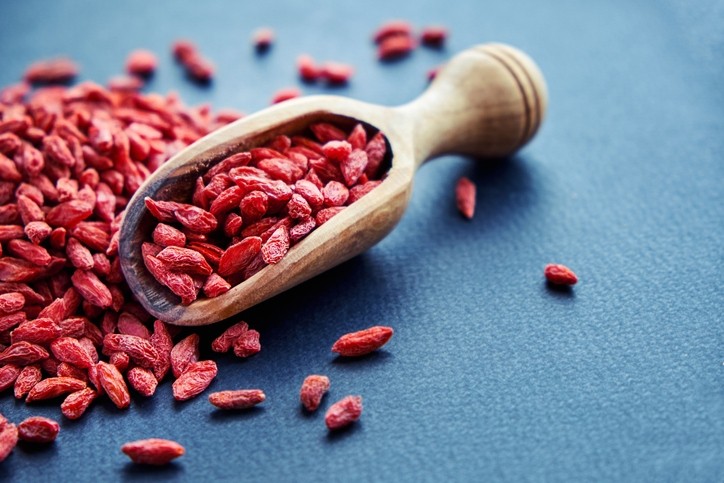Goji’s looking good: Review supports wolfberry’s benefits in preventing or delaying eye diseases

Wolfberry is traditionally used in Chinese cuisine, in tea, soup, porridge for enhancing vision, longevity as well as a remedy for diabetes.
Its bioactive components such as carotenoids, polysaccharides, and flavonoids exhibit antioxidant, anti-inflammatory, and neuroprotective properties which are said to confer retinal benefits.
In this review, researchers from Singapore evaluated existing studies of wolfberry and three retinal conditions, namely age-related macular degeneration (AMD), diabetic retinopathy (DR), and retinitis pigmentosa (RP).
There are many experimental therapies under investigation aiming to repair or rescue impaired vision, although an effective treatment has yet to be discovered.
“We hope that this review article will not only increase awareness amongst the medical and scientific community regarding published work on F. lycii and retinal diseases, but will also help promote robust research work in this area to establish dietary intervention strategies aiming to promote ocular health and prevent common retinal diseases in the ageing population,” researchers wrote in the Nutrients journal.
Age-related macular degeneration
In most retinal diseases, a common cause is oxidative damage.
AMD is characterised by the progressive loss of central vision and is the leading cause of blindness among individuals over 50 years of age in developed countries.
This irreversible retinal disease will become a major public health burden globally due to the rapidly ageing populations, particularly in Asia, which accounts for more than 60% of the world’s population.
Several studies have evaluated wolfberry extracts on AMD in animal models, human cell lines and human clinical trials.
To date, there are three prospective randomised controlled clinical trials studying wolfberry supplementation on human subjects with AMD.
Bucheli et al. (2011) reported that wolfberry supplementation (13.7g/day for 90 days) decreased hypopigmentation in the macula, and increased plasma zeaxanthin by 26%, and antioxidant capacity by 57%.
Hypopigmentation is an early symptom of AMD. Wolfberries are a rich source of the carotenoid zeaxanthin, containing around 60 to 70 times more zeaxanthin (35.7mg) compared to egg yolk (0.29mg), another rich source of zeaxanthin.
Vidal et al. (2014), found that wolfberry supplementation (13.7g/day for 90 days) increased plasma antioxidant and antibody response following an influenza vaccine, reinforcing immune defenses in elderly subjects. This decreases the likelihood of developing AMD.
Li et al. (2018), found wolfberry supplementation (25g/day for 90 days) increased macular pigment optical density, which authors speculate significantly increased visual acuity (eyesight).
Retinitis pigmentosa
Another common retinal condition, RP is characterised by the progressive loss of rod and cone photoreceptors, ultimately leading to complete blindness.
According to researchers, the retina is highly vulnerable to oxidative stress, and antioxidant treatment have been found to improve cell survival and preserve photoreceptors function in animal models/cell lines.
Currently, neuroprotection using antioxidant is widely employed as a therapeutic approach to delay photoreceptor degeneration in RP patients.
To date, one human study by Chan et al. (2019) found that wolfberry supplementation (10g/day for 12 months) could preserve macular thickness and structure, as well as visual acuity.
Wolfberry may exhibit neuroprotective effect on the human retina and might help to minimise or delay cone degeneration in RP patients.
The authors proposed that F. lycii may be useful as a dietary supplement to effectively preserve photopic vision in RP patients and to help maintain quality of life.
Diabetic retinopathy
DR is another common microvascular complication as a result of diabetes. More than one third of those with diabetes worldwide have some form of DR.
While the mechanisms underlying diabetic microvascular complications remain unclear, researchers think hyperglycemia-induced oxidative stress play an important role in the onset DR.
To date, there are no studies evaluating wolfberry supplementation and DR in human clinical trials.
However, there are studies in animal models and human cell lines, which have been shown to ameliorate retinal functional changes due to diabetes these studies.
Future directions
Currently, most studies of wolfberry in AMD, DR, and RP have been conducted in animal models or human cell lines.
However, researchers said these findings may be limited due to differences between species.
For instance, rodents lack a macula, and rod cells are its predominant retinal photoreceptors, whereas humans have specialised macula with cone cells as the main photoreceptors.
With the small number studies done on human subjects, wolfberry is considered a safe dietary supplement at 15g per day, equivalent to 3 mg/day of zeaxanthin, deemed beneficial for ocular health.
However, researchers called for more observational and interventional studies, particularly long-term supplementation studies using wolfberry involving human subjects with retinal diseases to confirm the observed protective effect in retinal diseases.
In addition, there are currently no research grade F. lycii available in the market for conducting scientific studies, resulting in a lack of standardisation and quality control for the bioactive components.
“It is thus crucial to ensure the availability of research grade F. lycii with consistent concentration of bioactive components to promote quality research in this field,” they explained.
Researchers emphasised that F. lycii must also be retailed with strict adherence to pharmacopoeia-recommended guidelines, including dosage regimes.
The observations from this review suggest F. lycii as an inexpensive and relatively safe dietary supplement for the maintenance of retinal health as well as for the prevention or delay in progression of retinal diseases commonly seen in clinical practice.
“F. lycii supplementation may represent a model for modern medicine with successful integration between traditional Asian and Western medicine reaping the advantage of multi-functional herbal ingredients in the prevention and treatment of retinal diseases.”
Source: Nutrients
https://doi.org/10.3390/nu13010246
“Fructus lycii: A Natural Dietary Supplement for Amelioration of Retinal Diseases”
Authors: Kumari Neelam, et al.



















